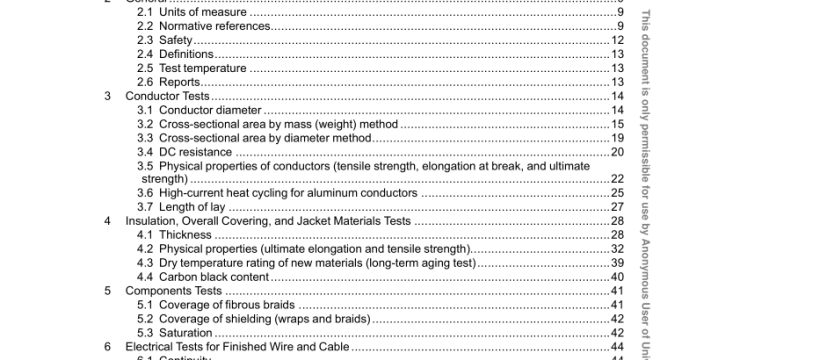UL 2556-2021 pdf download.Wire and Cable Test Methods.
4 Insulation, Overall Covering, and Jacket Materials Tests 4.1 Thickness 4.1.1 Scope The tests in this clause establish methods for determining the minimum thickness at any point, and the average thickness of conductor insulation, extruded overall covering, and jacket materials. 4.1.2 Apparatus The apparatus shall consist of the following, whichever are applicable: a) a pin-gauge dial micrometer capable of exerting a force of 0.25 ±0.02 N (0.056 ±0.004 lbf), having a nominal pin diameter of 1 mm (0.04 in) and an anvil having nominal dimensions of 1 mm by 8 mm (0.043 in by 0.312 in), and with a resolution and accuracy of 0.01 mm (0.001 in); b) a micrometer microscope with a resolution and accuracy of 0.01 mm (0.001 in), except that in the case of referee measurements taken following non-compliance in accordance with 4.1.4.1.3, 4.1.4.2.3 or 4.1.4.2.4, the resolution and accuracy shall be 0.001 mm (0.0001 in); c) a dial micrometer having flat surfaces on both the anvil and the end of the spindle that exerts a force of 0.10 to 0.83 N (0.022 to 0.187 lbf), both the spindle and anvil having nominal dimensions of: 1) 2 mm by 9.5 mm (0.078 in by 0.375 in), with a resolution and accuracy of 0.01 mm (0.001 in); or 2) 6.4 mm (0.25 in) in diameter with a resolution and accuracy of 0.01 mm (0.001 in); d) a laser micrometer with a resolution and accuracy of 0.01 mm (0.001 in); e) for mineral insulated cable, a file for flattening and smoothing the face of specimens; and f) for mineral insulated cable, a steel gauge wire of a specified diameter.
4.1.3 Preparation of specimens 4.1.3.1 Minimum thickness at any point 4.1.3.1.1 A specimen having a maximum length of 8 mm (0.31 in), but in no case longer than the width of the anvil, shall be cut perpendicular to the longitudinal axis of the cable and removed. Any separators or other components shall be removed from the insulation or jacket under examination. If the jacket or insulation cannot be removed without damage, measurements shall be made using the micrometer microscope method described in 4.1.4.1.2. 4.1.3.1.2 In the case of mineral insulated cable, the face of one end of a specimen 8 mm (0.31 in) in length shall be filed to provide a surface that is flat and smooth. The mineral insulation shall then be removed to a depth of 3 mm (0.12 in) below the end of the sheath without disturbing the original position of the conductor(s). NOTE: The specimen may be cut into segments to fit into the gauge. 4.1.3.2 Average thickness 4.1.3.2.1 Pin gauge and micrometer microscope methods A specimen shall be cut and prepared in accordance with 4.1.3.1. 4.1.3.2.2 Difference method A specimen of any convenient length shall be cut. 4.1.4 Procedure 4.1.4.1 Minimum thickness at any point 4.1.4.1.1 Pin gauge method The specimen shall be placed on the pin, the movable members of the gauge permitted to come gently to rest on the specimen, and the thickness shall be read. In rotating the specimen, the movable member shall not be in contact with it. The procedure shall be repeated until the minimum thickness is found and recorded.
4.1.4.1.4.2 In case of non-compliance with the specified minimum jacket thickness at any point, a micrometer microscope or other optical instrument according to 4.1.2 (b) shall be used to locate and measure the maximum and minimum thicknesses on each of the slices. 4.1.4.2 Average thickness 4.1.4.2.1 Averaging method The minimum and maximum thickness shall be determined using the procedures described in 4.1.4.1.1 or 4.1.4.1.2. For insulation, measurements shall be made within the irregularities resulting from conductor stranding. For extruded-to-fill jackets, all measurements shall be made within the irregularities resulting from the conductors or other components. If the pin described in 4.1.4.1.1 does not fit within the irregularities, this method is not applicable. 4.1.4.2.2 Difference method 4.1.4.2.2.1 For insulation only, the average thickness shall be determined by determining the diameter over the insulation and the diameter over the uninsulated conductor. The minimum and maximum diameter over the insulation shall be measured at three points spaced no less than 50 mm (2 in) apart along the axis of the specimen and recorded. The average conductor diameter shall be determined in accordance with 3.1. The average thickness of insulation shall be calculated in accordance with 4.1.5.2.2. 4.1.4.2.2.2 For flexible cords only, the average thickness of jacket may be determined by measuring the diameter over the jacket and the diameter over core, including separator, under the jacket. The minimum and maximum diameter over the jacket and the core shall be measured at three points spaced no less than 50 mm (2 in) apart along the axis of the specimen and recorded. The average thickness of jacket shall be calculated in accordance with 4.1.5.2.2.UL 2556-2021 pdf download.
UL 2556-2021 pdf download
